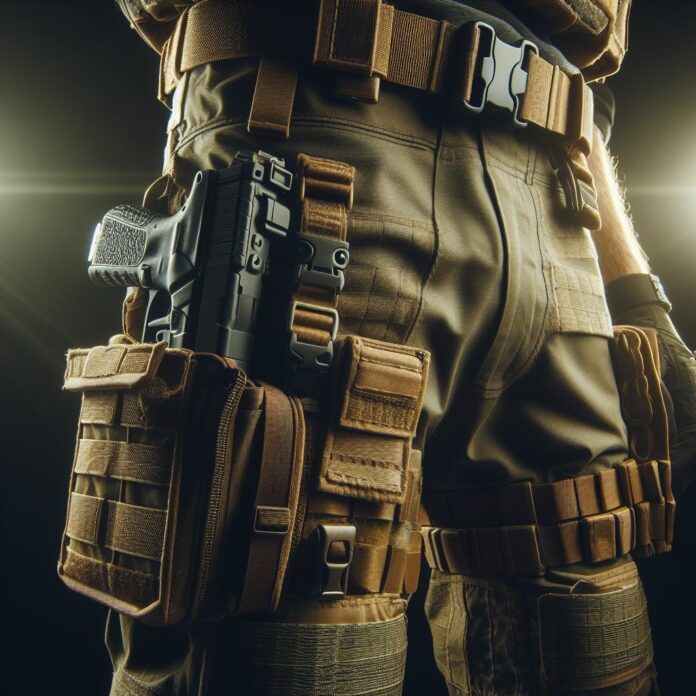Holsters play a crucial role in securely and safely carrying firearms. Choosing the right materials for a holster is essential to ensure durability, retention, comfort, and concealment. Various materials are commonly used, each with its own unique characteristics and benefits.
Leather holsters are a popular choice known for their classic look, durability, and excellent retention. Different types of leather, such as cowhide or horsehide, offer varying levels of strength and flexibility. Proper maintenance and care are necessary to maintain the shape and quality of leather holsters.
Kydex holsters, on the other hand, are made from a thermoplastic material that is lightweight, durable, and offers excellent retention. Kydex holsters can be easily molded and customized to fit specific firearm models, providing a secure and precise fit. Maintenance and care for Kydex holsters are minimal, requiring only occasional cleaning.
Nylon holsters are known for their versatility and comfort. They are lightweight, affordable, and suitable for various carry positions. Nylon holsters often feature adjustable retention systems and additional padding for enhanced comfort. Cleaning nylon holsters is also relatively easy.
Hybrid holsters combine different materials to offer a balance of comfort, durability, and retention. For example, a hybrid holster may have a leather backing for comfort against the skin and a Kydex or nylon shell for added retention. Maintenance and care for hybrid holsters typically depend on the materials used.
Other materials used for holsters include polymer, carbon fiber, and synthetic fabrics. Polymer holsters are lightweight, impact-resistant, and provide exceptional retention. Carbon fiber holsters are known for their strength and rigidity. Synthetic fabric holsters offer moisture resistance and breathability, making them suitable for active lifestyles.
When choosing the best material for a holster, it is important to consider factors such as personal preference, intended use, and compatibility with the firearm. By understanding the characteristics and benefits of different materials, you can make an informed decision and select a holster that meets your specific needs.
Factors to Consider when Choosing Materials for a Holster
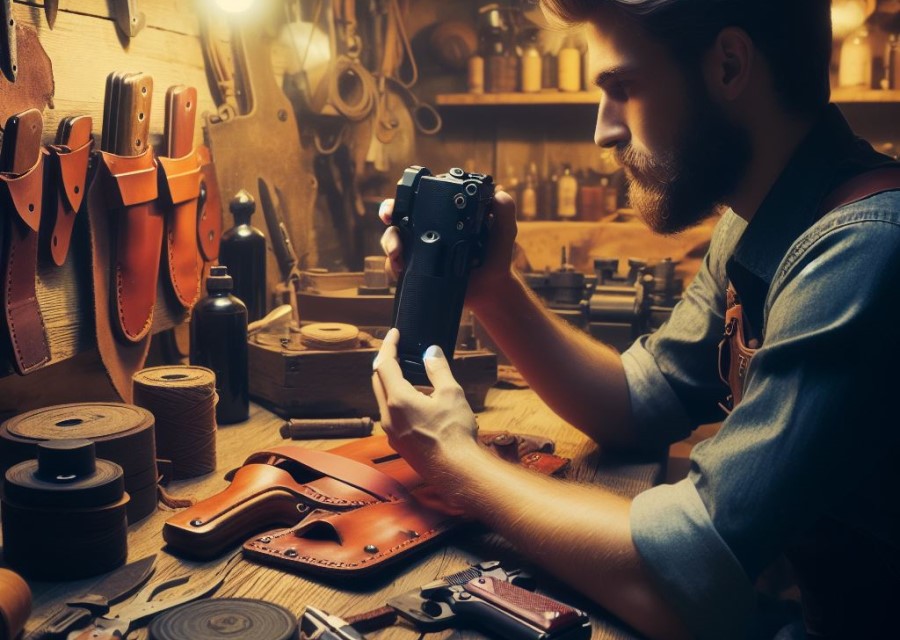
When it comes to choosing the perfect materials for a holster, there are several factors to keep in mind. In this section, we’ll dive into what you need to know before making a decision.
From durability, retention, comfort, to concealment, we’ll explore how each aspect plays a crucial role in finding the ideal holster material. So, let’s get started and discover what materials will provide the best fit for your holster needs!
Durability
The durability of a holster varies depending on the material used. Leather holsters are known for their high durability, providing long-lasting use. Kydex holsters offer very high durability, ensuring strength and resistance to wear and tear.
Nylon holsters offer moderate durability, being less resistant to damage than leather or Kydex. Hybrid holsters, which combine different materials, have varying levels of durability depending on the specific combination.
Polymer holsters have a high level of durability, making them reliable options. Carbon fiber holsters offer very high durability, thanks to the strength of the material.
Synthetic fabric holsters provide moderate durability, offering a balance between strength and flexibility. Consider the durability of the holster material based on your specific needs and the intended use of the holster.
Retention
Retention is a crucial factor to consider when choosing a holster. It is the ability of the holster to securely hold the firearm in place, preventing accidental falls or unauthorized access. Here are some important points to keep in mind regarding retention:
- Adjustability: A high-quality holster should have adjustable retention mechanisms, such as retention screws or straps. This allows users to customize the level of retention based on their preferences.
- Audible Click: A positive audible click when inserting the firearm into the holster is often a sign of good retention. This sound confirms that the firearm is securely held in place.
- Retention Level: Different holsters offer varying levels of retention. Some holsters have active retention systems like thumb breaks or retention hoods, while others rely on passive retention such as friction or tension. The appropriate retention level depends on the user’s specific requirements and circumstances.
- Drawing Speed: A well-designed holster strikes a balance between retention and ease of draw. It should facilitate a smooth and quick draw while keeping the firearm securely in place under normal conditions.
- Training: Proper training and practice are crucial for safe and efficient drawing and reholstering of the firearm. Mastering holster retention techniques is essential to prevent accidental discharges or mishaps.
Remember that retention plays a vital role in the safety and security of both the user and those around them. When choosing a holster, it is important to select one that offers the appropriate level of retention for your specific needs while ensuring a smooth and efficient draw when necessary.
Comfort
When choosing a holster, comfort is a crucial factor to consider. The level of comfort you experience while using the holster can greatly impact your overall satisfaction and effectiveness. Here are some key points to keep in mind:
- Fit: To ensure a comfortable experience, it is essential that the holster has a snug fit, securely holding your firearm in place. Avoid holsters that are either too tight or too loose, as they can cause discomfort and hinder your ability to draw smoothly.
- Material: The material of the holster plays a significant role in providing comfort. Leather and nylon holsters are popular choices due to their flexibility and ability to conform to your body shape, resulting in a comfortable fit.
- Padding: Some holsters come with additional padding to enhance comfort. This padding helps distribute the weight of the firearm more evenly, minimizing pressure points and discomfort.
- Adjustability: Look for holsters that feature adjustable straps or retention systems. This allows you to customize the fit and angle of the holster according to your preferences, ensuring optimal comfort while carrying.
- Smooth Edges: A comfortable holster should have smooth and rounded edges to prevent any irritation or discomfort against your skin. Avoid holsters with rough or sharp edges, as they can cause chafing or dig into your body.
Concealment
When choosing a holster, concealment is a crucial factor to consider. It determines how effectively the holster can hide your firearm from view. Here are some important points to keep in mind:
- Tight fit: Opt for a holster that provides a snug and secure fit around your firearm. This helps minimize printing or visible outlines, enhancing concealment.
- Adjustability: Look for a holster that offers adjustable retention or ride height settings. This allows you to position the holster in a way that maximizes concealment while ensuring easy access to your firearm.
- Cover garments: Consider the type of clothing you typically wear and how the holster will work with it. Loose-hanging garments or those with additional layers (such as jackets or vests) can assist in concealing your firearm.
- Positioning options: Different holsters offer various carry positions, such as appendix carry, hip carry, or small-of-back carry. Select a position that fits well with your body type and allows for effective concealment.
- Holster design: Specific holsters, like inside-the-waistband (IWB) or pocket holsters, are designed to enhance concealment. They are discreet and minimize the visibility of the firearm.
When choosing a concealed carry holster, it is vital to prioritize comfort, ease of access, and proper function. Remember to practice drawing and reholstering your firearm while wearing the chosen holster to ensure it effectively meets your needs.
Leather Holsters
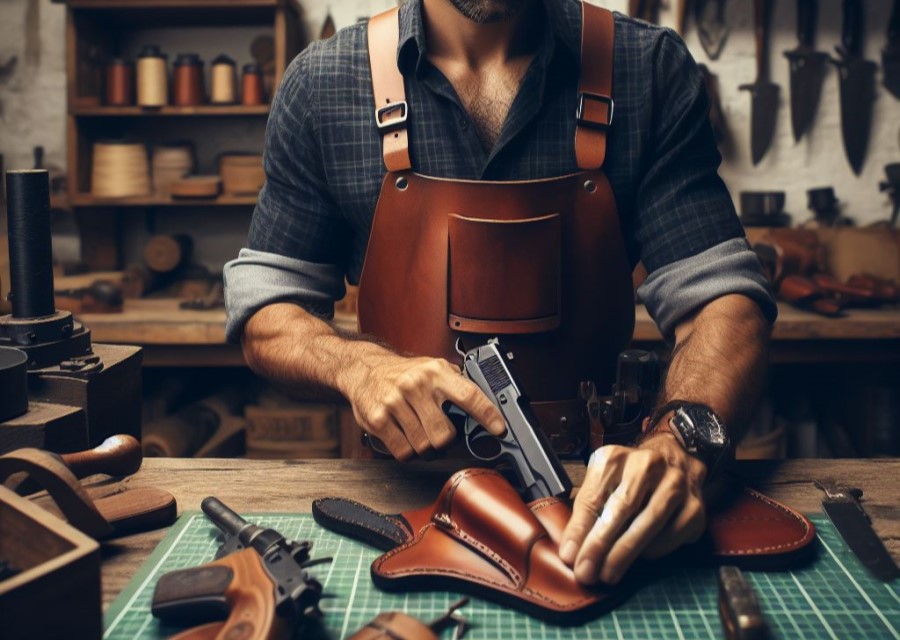
When it comes to holsters, leather is a classic choice that deserves a closer look. In this section, we’ll uncover the fascinating world of leather holsters, exploring their characteristics, various types of leather used, and how to effectively maintain and care for them.
So, buckle up and get ready to discover why leather continues to be a top contender in the realm of holster materials.
Characteristics and Benefits
The characteristics and benefits of different materials used for holsters include:
- Leather:
- Leather holsters are known for their durability, offering long-lasting use.
- They provide good retention, securely holding the firearm in place.
- Wearing a leather holster is comfortable throughout the day.
- Leather holsters offer effective concealment, keeping the firearm hidden.
- Kydex:
- Kydex holsters are highly durable, ensuring their longevity.
- They can be molded for a custom fit, providing optimal comfort.
- Maintaining and cleaning Kydex holsters is easy and hassle-free.
- Nylon:
- Nylon holsters are lightweight and versatile, suitable for various situations.
- They offer comfortable everyday carry, ensuring ease of use.
- Nylon holsters are resistant to water and weather, providing reliable protection.
- They are easy to clean and maintain, simplifying upkeep.
- Hybrid (Combination of Materials):
- Hybrid holsters offer a balance of comfort and durability, catering to different preferences.
- They provide good retention and concealment, ensuring the firearm stays secure and hidden.
- Maintaining and cleaning hybrid holsters is convenient and straightforward.
- Other Materials (Polymer, Carbon Fiber, Synthetic Fabrics):
- Each material has its own unique characteristics and benefits that cater to different needs.
- These materials may offer specific advantages in terms of weight, durability, or customization.
- The maintenance requirements may vary based on the specific material used.
Types of Leather Used
The table below showcases the various Types of Leather Used in holster manufacturing along with their Characteristics and Benefits.
| Type of Leather | Characteristics | Benefits |
|---|---|---|
| Veg-Tanned Leather | Stiff and durable | Provides excellent retention and long-lasting use |
| Full-Grain Leather | Strong and resistant to wear | Offers superior durability and a polished appearance |
| Top-Grain Leather | Smooth and flexible | Provides a comfortable fit and molds to the shape of the gun over time |
| Exotic Leather (e.g., Alligator, Shark) | Distinctive texture and pattern | Offers a unique and stylish look for holster enthusiasts |
These are just a few examples of the types of leather commonly used in holster production. Each type has its own qualities and advantages, so it’s essential to consider your specific needs and preferences when choosing the best leather for your holster.
Keep in mind factors such as the gun’s size, weight, and your intended use to ensure the leather type aligns with your requirements.
Maintenance and Care
Maintenance and care of a holster are essential to ensure its longevity and optimal performance. Proper maintenance can prolong the lifespan of the holster and keep it in good condition for years to come. Here are some important aspects to consider when it comes to maintenance and care:
1. Regular cleaning: It is important to clean your holster regularly to remove dirt, debris, and sweat that may accumulate over time. Use a soft cloth or brush to gently wipe the surface of the holster. Avoid using harsh chemicals or abrasive materials that can damage the holster.
2. Storage: When not in use, store your holster in a cool and dry place to prevent moisture buildup and mold growth. Avoid exposing it to extreme temperatures or direct sunlight, as these can cause the material to deteriorate.
3. Lubrication: Depending on the type of holster, maintenance and care lubrication may be necessary for proper maintenance and care to ensure the smooth operation of moving parts. Apply a small amount of appropriate lubricant to the recommended areas to keep the holster functioning properly.
4. Inspections: Regularly inspect your holster for any signs of wear or damage. Check for loose stitching, worn-out straps, or cracks in the material. Address any issues promptly to prevent further damage and maintain the holster’s integrity.
5. Adjustments: If your holster has adjustable retention or straps, periodically check and adjust them as needed to ensure a secure fit for your firearm.
By following these maintenance and care practices, you can keep your holster in excellent condition and ensure it functions reliably whenever you need it. Remember, proper maintenance not only extends the lifespan of your holster, but it also contributes to your safety and the longevity of your firearm.
Kydex Holsters
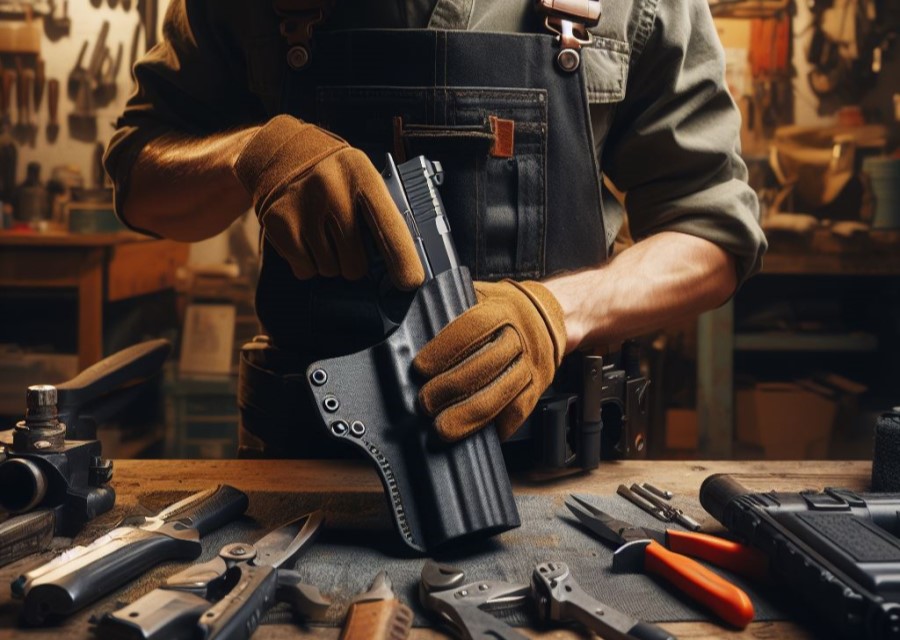
Kydex holsters are the go-to choice for many gun enthusiasts, offering a unique blend of characteristics and benefits that set them apart from other materials.
In this section, we’ll dive into the world of Kydex holsters, exploring their moldability and customization options, as well as sharing tips for their maintenance and care.
Get ready to discover why Kydex is the top pick for those seeking reliability, versatility, and a personalized touch in their holsters.
Characteristics and Benefits
| Material | Characteristics | Benefits |
| Leather | Durable, flexible, and molds to the shape of the firearm | Provides a classic and stylish look, comfortable to wear, and offers good retention |
| Kydex | Rigid and retains its shape, lightweight | Offers excellent retention, easy to clean, and resistant to moisture and chemicals |
| Nylon | Soft and flexible, lightweight | Cost-effective, offers good comfort, and provides flexibility for various carry positions |
| Hybrid | Combines the features of different materials | Offers a balance between comfort and retention, customizable, and provides versatility |
| Other materials (Polymer, Carbon Fiber, Synthetic Fabrics) | Varies depending on the specific material | Can offer lightweight options, increased durability, and specific functionality based on the material used |
Finding the right holster material depends on individual preferences, the type of firearm, and the intended use. Consider factors such as comfort, retention, and style when choosing the best material for your holster.
Fact: Leather is a popular choice for holsters due to its long-lasting durability and timeless aesthetic.
Moldability and Customization
The moldability and customization of a holster are crucial aspects to consider when selecting the ideal material. To gain a better understanding of this factor, let’s examine a comparison table:
| Material | Moldability | Customization |
| Kydex | High | High |
| Leather | Low | Medium |
| Nylon | Medium | Medium |
| Hybrid | Medium | High |
Kydex holsters offer a high degree of moldability, which enables a precise fit for your firearm. This material can be shaped and formed to perfectly match the contours of your gun, ensuring excellent retention and secure protection. Moreover, Kydex holsters can be easily customized with a variety of attachments and accessories, such as belt loops or adjustable retention systems.
On the other hand, leather holsters have lower moldability but provide a classic and stylish appearance. Although they may not conform as closely to the firearm, they can still be customized to some extent with different finishes and colors.
Nylon holsters offer moderate moldability and customization options. They are flexible and can adapt to various gun shapes, although they may lack the precise fit of Kydex holsters. Nevertheless, they provide a wide range of colors and patterns to suit individual preferences.
Hybrid holsters combine different materials, usually Kydex and leather or nylon. This combination allows for moderate moldability and high customization options. The Kydex component ensures the necessary retention and protection, while the leather or nylon provides comfort and style.
When choosing a holster, consider the level of moldability and customization that aligns with your specific needs and preferences. Whether you prioritize a precise fit, unique customization options, or a blend of functionality and style, there is a material available to fulfill your requirements.
Maintenance and Care
Maintenance and care are essential for maintaining the longevity and functionality of a holster, regardless of its material.
- To keep leather holsters in good condition, regular maintenance and care are required. It is advisable to clean and condition them regularly using leather-specific products to prevent drying and cracking.
- Kydex holsters are relatively low-maintenance and easy to take care of. You can simply wipe them clean with a damp cloth and mild soap. Avoid using harsh chemicals or solvents that could cause damage to the material.
- Nylon holsters can be conveniently cleaned in a washing machine. It is recommended to use a mild detergent and air dry them to prevent shrinkage or damage to the material.
- Hybrid holsters, which combine different materials, may require specific care instructions depending on the components used. Follow the maintenance guidelines provided by the manufacturer to ensure proper care.
- Regardless of the material, it is important to regularly inspect the holster for any signs of wear, such as loose stitching or fraying. If any issues are noticed, it is recommended to address them promptly to prevent further damage.
By following proper maintenance and care practices, you can extend the lifespan of your holster and ensure its continued ability to effectively hold and protect your firearm.
Nylon Holsters
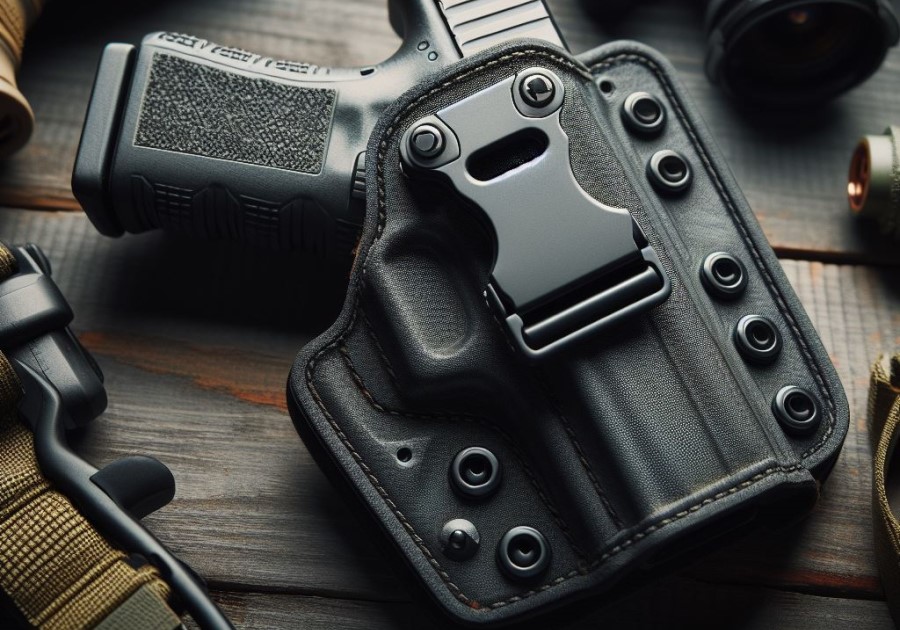
When it comes to holsters, nylon is a material that offers unique and impressive qualities. In this section, we’ll dive into the world of nylon holsters and explore their characteristics, benefits, versatility, comfort, as well as proper maintenance and care.
Get ready to discover why nylon is a top choice for holster enthusiasts and learn how this material can enhance your carrying experience.
Characteristics and Benefits
When it comes to choosing a holster, it is important to consider the characteristics and benefits of different materials. Each material has its own strengths and features that make it suitable for different needs and preferences.
| Material | Characteristics | Benefits |
| Leather | Durable, flexible, and molds to the shape of the gun | Offers a classic and stylish look, provides excellent retention and comfort |
| Kydex | Lightweight, rigid, and holds its shape | Provides quick and smooth draw, offers excellent retention and durability |
| Nylon | Flexible, lightweight, and affordable | Allows for easy adjustment and comfort, offers good retention and versatility |
| Hybrid | Combination of materials like leather and Kydex | Provides a balance of comfort and retention, offers customization options |
| Other materials (Polymer, Carbon Fiber, Synthetic Fabrics) | Vary depending on the specific material | Can offer lightweight and durable options, may provide additional features like adjustable retention |
By considering the characteristics and benefits of each material, you can find a holster that best suits your needs in terms of comfort, retention, durability, and style.
Versatility and Comfort
Versatility and comfort are crucial factors to keep in mind when selecting a holster. The versatility of a holster allows for its usage in various situations and with different firearms. It is essential to look for a holster that can accommodate various gun models and sizes, ensuring a secure hold for your firearm, regardless of what you carry.
This flexibility ensures that the holster can serve multiple purposes, whether it’s for concealed carry, range practice, or even competitions.
Comfort plays a vital role, especially when wearing a holster for extended periods. It is important to find a holster designed with ergonomics in mind, offering adjustable straps, padding, or breathable materials.
A comfortable holster should fit snugly against your body, minimizing any discomfort or irritation. Additionally, consider the weight distribution and how the holster sits on your hip or waist, ensuring it does not dig into your skin or cause strain.
By considering the versatility and comfort of a holster, you can find one that meets your specific needs and preferences. Remember that everyone is different, so what works for one person may not work for another. It is important to try out different holsters and find one that suits your individual comfort and carry style.
Whether you require a holster for everyday carry or specialized purposes, prioritize versatility and comfort to ensure a positive and practical experience.
Maintenance and Care
When it comes to maintenance and care, taking proper care of your holster is essential for its longevity and optimal performance.
- Clean regularly: It is important to regularly clean your holster to remove dirt, debris, and sweat that can accumulate over time. Use a soft cloth and mild soap to gently clean the surface of the holster. Remember to avoid using harsh chemicals or abrasive materials that can damage the material.
- Inspect for wear and tear: Make sure to periodically inspect your holster for any signs of wear and tear. Keep an eye out for cracks, loose stitches, or other damage that can compromise the functionality and safety of the holster.
- Store properly: When your holster is not in use, store it in a cool and dry place. Avoid exposing it to extreme temperatures or direct sunlight, as these factors can weaken the material and affect its durability.
- Avoid excessive moisture: Excessive moisture can cause damage to certain holster materials, especially leather. If your holster gets wet, gently pat it dry with a soft cloth and allow it to air dry completely before using or storing.
- Follow manufacturer guidelines: Different holster materials may have specific care instructions provided by the manufacturer. It is important to follow these guidelines to ensure proper maintenance and prolong the lifespan of your holster.
By incorporating these maintenance and care practices, you can ensure that your holster remains in good condition and continues to provide reliable performance for years to come.
Hybrid Holsters
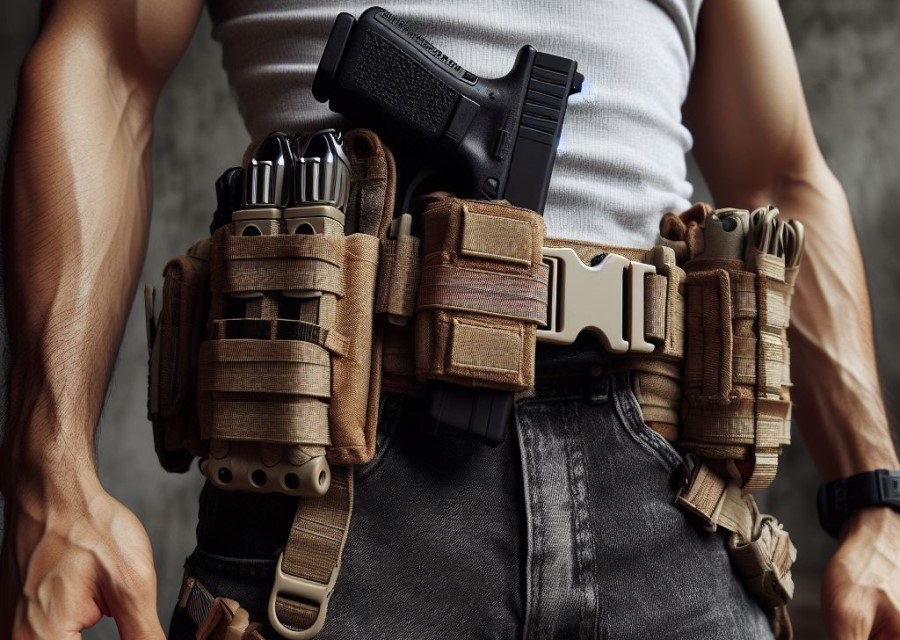
Hybrid holsters, the coveted choice among firearm enthusiasts. Discover the tantalizing characteristics, unparalleled benefits, and the magic of combining materials. From unbeatable durability to enhanced comfort, these holsters have it all.
Unveil the secrets behind their maintenance and care, ensuring a lifetime of reliable performance. Get ready to dive into the world of hybrid holsters and unlock the perfect blend of form, function, and peace of mind.
Characteristics and Benefits
The table below highlights the characteristics and benefits of different materials used for holsters:
| Material | Characteristics | Benefits |
| Leather | Durable, flexible, and molds to the shape of the firearm | Offers a classic and stylish appearance, provides excellent retention, and offers a comfortable fit |
| Kydex | Rigid and highly impact-resistant | Provides excellent retention and durability, is lightweight, and offers quick and easy draw |
| Nylon | Flexible and lightweight | Offers versatility in terms of fit, is comfortable to wear, and provides good retention capabilities |
| Hybrid | Combination of materials (e.g., leather and Kydex) | Offers the benefits of both materials such as excellent retention, durability, and comfort |
| Polymer | Durable and lightweight | Provides good retention, is resistant to wear and tear, and offers a customizable fit |
| Carbon Fiber | Extremely strong and lightweight | Offers exceptional durability, excellent retention, and a modern appearance |
| Synthetic Fabrics | Durable and lightweight | Provides flexibility, good retention, and is resistant to moisture and abrasion |
Each material has its own unique characteristics and benefits, making it important to consider your individual needs and preferences when choosing a holster.
Combination of Materials
The combination of materials in holsters offers unique advantages and versatility. By combining different materials, manufacturers can create holsters that excel in multiple areas.
| Material | Characteristics and Benefits | Maintenance and Care |
| Leather and Kydex | Combining leather and Kydex provides a balanced mix of durability, comfort, and retention. Leather adds a classic look and feel, while Kydex enhances the holster’s retention capabilities. This combination is commonly used for IWB (Inside-the-Waistband) holsters. | For leather, regular conditioning with leather balm is recommended to maintain its flexibility and prevent cracking. Kydex requires minimal maintenance, usually just wiping it clean with a damp cloth. |
| Nylon and Polymer | By combining nylon and polymer, holsters become lightweight, affordable, and easy to conceal. Nylon provides flexibility and comfort, while polymer offers excellent durability and retention. This combination is often used in OWB (Outside-the-Waistband) holsters. | Cleaning nylon holsters is as simple as using mild soap and water. Polymer holsters can be wiped clean with a damp cloth. |
| Leather and Carbon Fiber | Mixing leather and carbon fiber results in a holster that combines the elegance of leather with the strength and lightweight properties of carbon fiber. This combination provides excellent durability and superior retention. | Leather should be conditioned regularly, while carbon fiber can be cleaned with a cloth. Avoid exposing the holster to extreme temperatures to prevent damage. |
Maintenance and Care
When it comes to holsters, maintenance and care are crucial aspects to consider, regardless of the material used. Proper maintenance and care are essential for ensuring that the holster remains functional and in good condition for a longer period of time.
- Regularly cleaning the holster helps to remove dirt, dust, and debris that can accumulate over time. This can be done with a soft cloth or a brush, depending on the material.
- Regularly inspect the holster for any signs of wear and tear, such as loose stitching or cracks. Addressing these issues promptly can prevent further damage and ensure the longevity of the holster.
- When not in use, it’s essential to store the holster properly to prevent damage. This includes keeping it away from extreme temperatures or humidity, as these can affect the material and its functionality.
- When cleaning the holster, avoid using harsh chemicals or solvents that can damage the material. Stick to mild soaps or cleaners recommended by the manufacturer.
- Different materials may have specific care instructions provided by the manufacturer. It’s important to follow these guidelines to ensure proper maintenance and avoid voiding any warranties.
- Depending on the material, regular maintenance may be necessary. For example, leather holsters may require conditioning or applying leather polish to keep them supple and prevent cracking.
Proper maintenance and care of a holster not only prolong its lifespan but also contribute to its overall functionality and reliability when needed.
Other Materials for Holsters
Looking beyond traditional materials, let’s dive into the world of other materials used for holsters. We’ll explore the benefits and unique properties of polymer, carbon fiber, and synthetic fabrics.
From enhanced durability to improved weight distribution, these alternative materials offer a range of advantages for holster enthusiasts. So, let’s take a closer look at the exciting options beyond the usual suspects and discover the potential that awaits in the realm of holsters.
Polymer
A polymer is a widely used material for holsters due to its durability, versatility, and lightweight nature. It offers several benefits that make it a popular choice among gun owners.
Polymer holsters are known for their excellent impact resistance, making them highly durable and long-lasting.They offer a high level of retention, ensuring that the firearm remains securely in place.
These holsters provide a comfortable fit, with smooth edges and adjustable settings for tension and cant.They are designed for optimal concealment, with slim profiles and low visibility.
Maintenance and care for polymer holsters are relatively simple. They are resistant to moisture and can be easily cleaned with mild soap and water. Regular inspection for wear and tear is recommended, and any loose or damaged components should be replaced.
Carbon Fiber
Carbon fiber is an exceptional material for holsters, offering numerous benefits and characteristics.
Here is a table that highlights its key features:
1. Lightweight: Reduced weight for comfortable carrying
2. High strength: Provides excellent durability and resistance to impact
3. Low maintenance: Requires minimal care and upkeep
4. Sleek and modern appearance: Adds a stylish look to the holster
5. Minimal friction: Ensures smooth draw and re-holstering of the firearm
In addition to these benefits, carbon fiber is also known for its high thermal conductivity and resistance to temperature changes, making it suitable for various climate conditions.
Fact: Carbon fiber is widely used in industries such as aerospace and automotive due to its exceptional strength-to-weight ratio.
Synthetic Fabrics
Synthetic fabrics, such as nylon, polyester, or neoprene, are commonly utilized in holster manufacturing due to their durability, versatility, and affordability. These fabrics offer numerous benefits for holsters.
1. Durability: Synthetic fabrics are renowned for their robustness and resistance to wear and tear. They can endure harsh conditions while maintaining their shape and functionality over time, ensuring the long-lasting nature of the holster.
2. Versatility: Synthetic fabrics can be easily molded and shaped to fit various firearm models and sizes. They provide a secure fit, ensuring proper retention of the weapon in the holster.
3. Comfort: Holsters made from synthetic fabrics are often lightweight and flexible, making them comfortable to wear for extended periods. They offer a smooth and snag-free draw, enhancing the user’s experience.
4. Maintenance and Care: Synthetic fabrics are effortless to clean and maintain. They can be wiped clean with a damp cloth or washed if necessary. Additionally, these materials are moisture-resistant and can dry quickly, preventing the accumulation of mold or mildew.
It is important to note that while synthetic fabrics offer several advantages, they may not provide the same level of durability or customization options as other materials like leather or Kydex. However, they are a cost-effective option for those on a budget or seeking a more versatile holster solution.
Frequently Asked Questions
What are the best materials for a holster?
There are several materials commonly used for holsters, each with its own advantages and considerations. The best material for a holster depends on individual requirements and preferences. Let’s explore the options:
What are the advantages of leather holsters?
Leather holsters are a popular choice due to their durability, comfortable fit, and stylish appearance. They provide a secure fit for the weapon and offer a quiet draw. Additionally, high-quality premium leather holsters have a long-lasting lifespan, protect the handgun’s finish, and can be customized with various designs.
What are the benefits of synthetic holsters?
Synthetic holsters, typically made of special plastics, offer numerous benefits such as trigger guard protection, scratch resistance, and impact resistance. They are also waterproof and do not require a break-in period. However, it’s important to research and choose a reputable brand as the quality of synthetic holsters can vary.
Is Kydex a viable option for holsters?
Kydex holsters, made from a brand of plastic or polymer known for its chemical stability and scratch resistance, are a popular choice. They offer a universal fit, retain their shape well, and are easy to clean. Kydex holsters also provide good friction retention and minimize wear on the firearm. However, they may cause skin irritations and require additional accessories for effective concealment.
Are suede holsters a good choice?
Suede holsters, although less durable than nylon, can be a viable option for those on a budget or looking for a comfortable IWB concealed carry option. They are less expensive than leather or Kydex holsters and are aesthetically pleasing. However, suede holsters may lack friction retention, fit firearms too loosely, and are susceptible to moisture and gathering debris.
Can hybrid holsters provide the best of both worlds?
Hybrid holsters combine different materials, often featuring a Kydex shell and a padded or leather backing. These holsters offer a good mix of durability, comfortable wear, and easy draw/re-holster. They are frequently used for concealed carry and can provide a balance between stability and comfort. The pros and cons of hybrid holsters depend on the specific materials used in their construction.
What considerations should be kept in mind when choosing a holster material?
When selecting a holster material, important factors to consider include durability, comfort, retention options, and intended use. Leather holsters are known for their elegance and quality but may require a break-in period and additional care. Kydex holsters offer versatility and customization but can potentially cause discomfort. Fabric holsters are lightweight and affordable but may not last as long.

